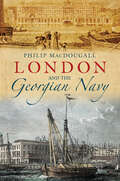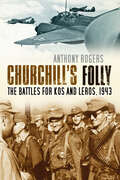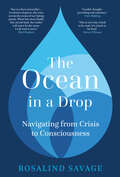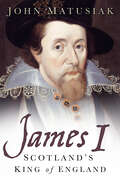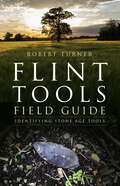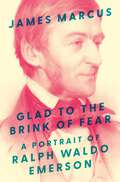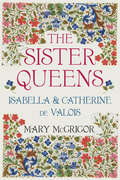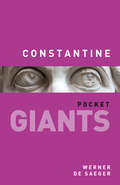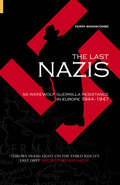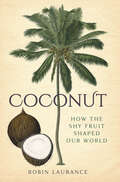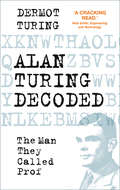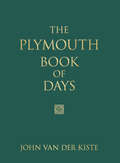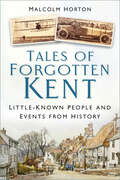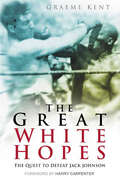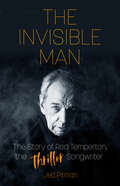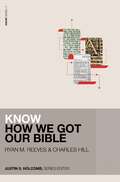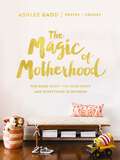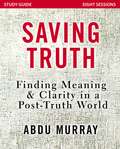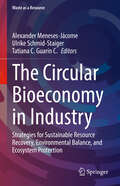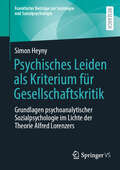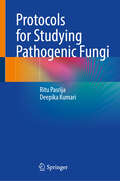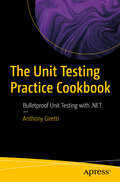- Table View
- List View
London and the Georgian Navy
by Philip MacDougall Philip MacdougallAt a time when the Royal Navy was the biggest and best in the world, Georgian London was the hub of this immense industrial-military complex, underpinning and securing a global trading empire that was entirely dependent on the navy for its existence. Philip MacDougall explores the bureaucratic web that operated within the wider city area before giving attention to London’s association with the practical aspects of supplying and manning the operational fleet and shipbuilding, repair and maintenance. His supremely detailed geographical exploration of these areas includes a discussion of captivating key personalities, buildings and work. The book examines significant locations as well as the importance of Londoners in the manning of ships and how the city memorialised the navy and its personnel during times of victory. An in-depth gazetteer and walking guide complete this fascinating study of Britain, her capital and her Royal Navy.
Churchill's Folly: The Battles for Kos and Leros, 1943
by Anthony Rogers Lord JellicoeIn autumn 1943 the Italian-held Dodecanese was the setting for the last decisive German invasion of the Second World War – and the last irreversible British defeat. After the Italian armistice that followed the downfall of Mussolini, Churchill seized the opportunity to open a new front in the eastern Mediterranean, thereby increasing the pressure against Germany and hoping to provide an incentive for Turkey to join the Allies. Rejected by the Americans, it was a strategy fraught with difficulties and doomed to fail. Spearheaded by the LRDG and SBS, British troops were dispatched to the Aegean with naval units, but little or no air cover. They were opposed by German assault troops with overwhelming air superiority. Within 3 months, German forces had seized nearly all of the Dodecanese, which was occupied until the end of the war.
The Ocean in a Drop: Navigating from Crisis to Consciousness
by Roz SavageThe bad news is that our civilisation is collapsing. The good news is that you are already helping create a new and better one.The Ocean in a Drop follows the quest of Roz Savage, a frustrated environmentalist and ocean adventurer, to find out why her own endeavours and the environmental movement more generally have failed to achieve change of the necessary scope, scale and speed. Her journey takes her from the environment through economics and politics into patriarchy and a global culture of domination – the domination of rich over poor, strong over weak, humanity over nature. She examines the tragic psychological flaws in the way we think, and the apparent inevitability of civilisational collapse, and deduces that our best hope is to transcend the current trap of runaway materialism. But how?Exploring cutting-edge theories on the nature of reality and the relationship between matter and consciousness, she peels back the veils of our shared delusions to arrive at a new narrative about what it means to be human in the twenty-first century. She paints a bold, exciting vision of a future in which people and planet thrive.
James I: Scotland's King of England
by John MatusiakFew kings have been more savagely caricatured or grossly misunderstood than England’s first Stuart. Yet, as this biography demonstrates, the modern tendency to downplay his defects and minimise the long-term consequences of his reign has gone too far.In spite of genuine idealism and flashes of considerable resourcefulness, James I remains a perplexing figure – a uniquely curious ruler, shot through with glaring inconsistencies. His vices and foibles not only undermined his high hopes for healing and renewal after Elizabeth I’s troubled last years, but also entrenched political and religious tensions that eventually consumed his successor. A flawed, if well-meaning, foreigner in a rapidly changing and divided kingdom, his passionate commitment to time-honoured principles of government would, ironically, prove his undoing, as England edged unconsciously towards a crossroads and the shadow of the Thirty Years War descended upon Europe.
Flint Tools Field Guide: Identifying Stone Age Tools
by Robert TurnerOur prehistoric ancestors used flint tools every day; they were of vital importance for cutting and scraping, used for hunting, preparing food, making clothing and building shelters, and their remnants are scattered around the countryside.Unearthing such a find is a magical moment – a direct link to events thousands of years before – but how do you identify the piece of flint you find out in the field? Is it only a lump of flint, or did it really have an important function as a tool prized by our ancestors? And how old is it, exactly?In Flint Tools Field Guide, archaeologist and flint knapper Robert Turner opens a window into prehistoric archaeology, using hand-drawn illustrations and photographs to explain how to identify tools and their uses, as well as approximate their age. This is an important insight into how people lived and worked so many years ago.
Glad to the Brink of Fear: A Portrait of Ralph Waldo Emerson
by James MarcusAn engaging reassessment of the celebrated essayist and his relevance to contemporary readersMore than two centuries after his birth, Ralph Waldo Emerson remains one of the presiding spirits in American culture. Yet his reputation as the starry-eyed prophet of self-reliance has obscured a much more complicated figure who spent a lifetime wrestling with injustice, philosophy, art, desire, and suffering. James Marcus introduces readers to this Emerson, a writer of self-interrogating genius whose visionary flights are always grounded in Yankee shrewdness.This Emerson is a rebel. He is also a lover, a friend, a husband, and a father. Having declared his great topic to be &“the infinitude of the private man,&” he is nonetheless an intensely social being who develops Transcendentalism in the company of Henry David Thoreau, Margaret Fuller, Bronson Alcott, and Theodore Parker. And although he resists political activism early on—hoping instead for a revolution in consciousness—the burning issue of slavery ultimately transforms him from cloistered metaphysician to fiery abolitionist.Drawing on telling episodes from Emerson&’s life alongside landmark essays like &“Self-Reliance,&” &“Experience,&” and &“Circles,&” Glad to the Brink of Fear reveals how Emerson shares our preoccupations with fate and freedom, race and inequality, love and grief. It shows, too, how his desire to see the world afresh, rather than accepting the consensus view, is a lesson that never grows old.
The Sister Queens: Isabella and Catherine de Valois
by Mary McGrigorIsabella de Valois was 3 years old when, on a hot August day in 1392, her father suddenly went mad. Less than four years later, she was married by proxy to the English King Richard II and arrived in England with a French retinue and her doll’s house. Richard’s humiliating deposition and brutal murder by his cousin, the future Henry IV, forced Isabella’s desperate return to France where she found her country fatally divided. Isabella’s sister, Catherine de Valois, became the beautiful young bride of Henry V and is unique in history for being the daughter of a king, the wife of a king, the mother of a king and the grandmother of a king. Like her sister, Catherine was viewed as a bargaining chip in times of political turmoil, yet her passionate love affair with the young Owain Tudor established the entire Tudor dynasty and set in motion one of the most fascinating periods of British history. The Sister Queens is a gripping tale of love, exile and conflict in a time when even royal women had to fight for survival.
Constantine: pocket GIANTS
by Werner SaegerWhy is Constantine a giant? Because he gave Christians freedom of religion. Yet also because he radically and thoroughly changed our society, in particular church-state relations, thereby creating the opportunity for the Christian community to experience exponential growth. Because his changes in government, law, religion and art and architecture are so enormous we still see the consequences of his decisions to this very day. Because Constantinian history is relevant to everyone.
The Last Nazis: SS Werewolf Guerrilla Resistance in Europe 1944-1947
by Perry BiddiscombeThe history of the shadowy Werewolf guerrilla bands formed at end of the Second World War as the last desperate defence of Nazis.Founded by Heinrich Himmler in 1944 when it became clear Germany would be invaded, the Werewolf guerrilla movement was given the task of slowing down the Allied advance to allow time for the success of negotiations or wonder weapons. Staying behind in territory occupied by the Allies, its mission was to carry out acts of sabotage, arson and assassination, both of enemy troops and of defeatist Germans.Perry Biddiscombe has researched the movement exhaustively, and details Werewolf operations against the British, Russians and fellow Germans, on the Eastern and Western Fronts and in the post-war chaos of Berlin. Giving the lie to the established story of a cowed German population meekly submitting to defeat, this is a fascinating insight into what has been described as the death scream of the Nazi regime.
Coconut: How the Shy Fruit Shaped our World
by Robin LauranceCoconuts have been around for longer than Homo sapiens; they have been turned into art, taken part in religious rituals and been a sign of wealth and success. They have saved lives, not only by providing nourishment, but also as part of the charcoal filers in First World War gas masks. It was coconuts that triggered the mutiny on the Bounty, and coconuts that saved the life of the man who went on to become the 35th President of the United States. The coconut has long been the unseen player in the endeavours of industrialists and bomb makers, physicians and silversmiths, smugglers and snake charmers. To this day, coconuts shape the lives of people around the world. At a time when coconut products crowd the shelves of supermarkets, health food shops and beauty salons, Robin Laurance looks beyond the oils and health drinks to uncover the unexpected, often surprising, and vital roles played by the coconut palm and its nut in times past and present.
Alan Turing Decoded: The Man They Called Prof
by Dermot Turing‘A cracking read. ’Nick Smith, Engineering and TechnologyAlan Turing was an extraordinary man who crammed into his 42 years the careers of mathematician, codebreaker, computer scientist and biologist. He is widely regarded as a war hero grossly mistreated by his unappreciative country, and it has become hard to disentangle the real man from the story. It is easy to cast him as a misfit, the stereotypical professor. But actually Alan Turing was never a professor, and his nickname ‘Prof’ was given by his codebreaking friends at Bletchley Park. Now Dermot Turing has taken a fresh look at the influences on his uncle’s life and creativity, and the creation of a legend. He discloses the real character behind the cipher-text, answering questions that help the man emerge from his legacy: how did Alan’s childhood experiences influence him? How did his creative ideas evolve? Was he really a solitary genius? What was his wartime work after 1942, and what of the Enigma story? What is the truth about the conviction for gross indecency, and did he commit suicide? In Alan Turing Decoded, Dermot’s vibrant and entertaining approach to the life and work of a true genius makes this a fascinating and authoritative read.
The Plymouth Book of Days (Book of Days)
by John KisteTaking you through the year day by day, The Plymouth Book of Days contains a quirky, eccentric, amusing or important event or fact from different periods of history, many of which had a major impact on the religious and political history of England as a whole. Ideal for dipping into, this addictive little book will keep you entertained and informed. Featuring hundreds of snippets of information gleaned from the vaults of Plymouth’s archives, it will delight residents and visitors alike.
Tales of Forgotten Kent: Little-Known People and Events from History
by Malcolm HortonTales of Forgotten Kent is a collection of twenty-two essays about the people and events that have largely been neglected by historians, but remain an integral part of Kent’s rich tapestry, featuring the eccentric, unusual and often overlooked tales buried within the garden of England.Who would have thought that the cradle of British aviation was the unfashionable Isle of Sheppey, home to Britain’s first licensed pilots and the world’s first aircraft manufacturers; or that the greatest technological change in printing – computer typesetting – occurred in the small town of Westerham; and that the poet who wrote the first sonnet was not actually Shakespeare but Sir Thomas Wyatt of Allington Castle, lover of Anne Boleyn; or that Britain’s oldest school is The King’s School, Canterbury, whose alumni includes the controversial playwright Christopher Marlowe, and still plays host to ghostly legends.Read on to unearth more of Kent’s best kept secrets and keep its forgotten tales alive.
The Great White Hopes: The Quest to Defeat Jack Johnson
by Graeme Kent Harry CarpenterIn 1908 black fighter Jack Johnson won the heavyweight championship of the world. There was an immediate storm of protest: it was predicted - accurately - that his reign would lead to civic unrest and race riots. Over the next seven years, more than 30 fighters lured by the prospect of fame tried to beat Jackson. This title tells the story.
Curtain Down at Her Majesty's: The Death of Queen Victoria in the Words of Those Who Were There
by Stewart Richards'Her Majesty the Queen breathed her last at 6.30 p.m., surrounded by her children and grand-children.' With this notice, pinned to the entrance gate of Osborne House, Queen Victoria's doctors announced the death of the most powerful woman in the world, who had sat on her throne and ruled through more than six decades. Her rule had seen her kingdom spread to become the world's biggest empire, had seen massive change in society and leaps forward in technology. It is little surprise that the death of one who had ruled for all of many people's lives created chaos, shock and mass outpourings of grief across the country. Here author and researcher Stewart Richards has delved through the archives to put together the definitive view of Victoria in her final days, through the immediate reaction and aftermath of her death, to the state funeral of 2 February 1901. Based entirely on fascinating first-hand accounts, The Death of Queen Victoria offers a truly unique insight into the events of that tumultuous few days and is a volume that no enthusiast should be without.
The Invisible Man: The Story of Rod Temperton, the 'Thriller' Songwriter
by Jed Pitman‘My favourite moment is when I finish a song, that is the moment I cherish.’ – Rod TempertonThe Invisible Man tells the remarkable story of how Rod Temperton worked his way up from a Grimsby fish factory to become one of the most successful songwriters of all time.Born in Cleethorpes in 1949, Temperton embarked on a career in music with the funk band Heatwave, for whom he wrote the international hits ‘Boogie Nights’ and ‘Always and Forever’, before his songwriting talent caught the attention of Michael Jackson’s legendary producer, Quincy Jones.For Jackson’s Off the Wall album, Temperton penned both the hit ‘Rock with You’ and the album’s title track. Three years later, he started work on what would become the best-selling album of all time – Michael Jackson’s Thriller – writing three songs, including the now legendary title track. And yet despite collaborating with some of music’s biggest stars, including Donna Summer and Michael McDonald, Temperton was famously reclusive and seldom gave interviews. Having enjoyed unprecedented access to the great man for his Sony Award-winning radio documentary on Temperton, Jed Pitman presents the fully updated, definitive story of one of music’s most talented individuals.
Know How We Got Our Bible (KNOW Series)
by Charles E. Hill Ryan Matthew ReevesThe easy accessibility of the Bible in most of the world's major languages can obscure a dramatic and sometimes unexpected story. In Know How We Got Our Bible, scholars Ryan Reeves and Charles Hill trace the history of the Bible from its beginnings to the present day, highlighting key figures and demonstrating overall the reliability of Scripture.Reeves and Hill begin with the writing of the Bible's books (including authorship and dating), move into the formation of the Old and New Testaments (including early transmission and the development of the canon), and conclude with several chapters on Bible translation from the Latin Vulgate to the ongoing work of translation around the world today.Written simply and focused on the overarching story of how the Bible came to us today, Know How We Got Our Bible is an excellent introduction for formal students and lay learners alike. Each chapter includes reflection questions and recommended readings for further learning.
The Magic of Motherhood: Enjoying Peace in His Presence (A 365-Day Devotional) – The Perfect Christian Gifts for Women
by Ashlee GaddThis book is a love letter to mothers everywhere. Discover a beautiful reminder of your identity, both as a woman and a mother.Are you an imperfect, trying-her-best mom? If you're stressed from overreading parenting advice, The Magic of Motherhood is the calming antidote you need. Ashlee Gadd and the writers behind the popular blog Coffee + Crumbs will help you see that you aren't alone and give you the words of encouragement you need to keep going. Motherhood. It flipped your world upside down in the most magical way. Who knew you could ever love and be loved this much? But it can also feel overwhelming and isolating. Your emotions swing between joy and uncertainty, contentment and anxiety, laughter and tears. Meanwhile, you secretly wonder, &“Am I the only one who feels this way?&”Rest assured: you, Momma, are not alone.The Magic of Motherhood is a curated collection of honest stories weaving together the love, joy, and magnificent heartache of motherhood. Instead of offering advice, the writers offer something even better: their hearts. You'll find heartwarming stories about:IdentityAdoptionBody imageMiscarriageFriendshipFaithAnd more After reading The Magic of Motherhood you will:Find joy in both beauty and messDiscover a renewed strength and sisterhoodBe reassured that they are not aloneWant to gift this book to all your friends on Mother's Day, birthdays, baby showers, National Best Friend Day, and other holidays This is a book about tiny miracles, answered prayers, and finding grace in the holy work of raising children. It's about the magic that happens between calm and chaos, the joy that can be found in both beauty and mess, and the valuable lessons we learn about ourselves in between cups of reheated coffee and kitchen tables covered in crumbs. Whether you are a brand-new mom or a bit more seasoned, The Magic of Motherhood will help you find the solidarity, comfort, and encouragement you need to be the mother God created you to be.
Saving Truth Study Guide: Finding Meaning and Clarity in a Post-Truth World
by Abdu MurrayHow Christians can guard their own minds against the lies that surround us and defend truth and clarity to a world that rejects both.By accurately describing the Culture of Confusion, the rise of the "post-truth" mindset, and how it has affected our society, author Abdu Murray will awaken you and your group to the plight we find ourselves in and challenge Christians to steer away from contributing to such a culture by instead finding hope in the clarity that Christ offers.In this eight-session, video-based study (DVD/streaming video sold separately) is designed to take you deeper into the topic of meaning and clarity through personal reflection and Scripture engagement and will:Help you understand the post-truth mindset and how it infects and affects us all.Equip you with facts and knowledge about the various areas of life where we are steeped in a post-truth mindset and losing our bearings as a culture, specifically: our freedom, our humanity, our sexuality, faith and science, and religious pluralism.Explain how the message of Jesus can answer our deepest questions, and how the actions of Jesus can bring truth and clarity to a post-truth culture desperately in need of objective, biblical truth. Increasingly, Western culture embraces confusion as a virtue and decries certainty as a sin. Those who are confused about morality are progressive pioneers. Those who are confused about spirituality are praised as tolerant. And those who express certainty about any of these issues are seen as bigoted, oppressive, or intolerant.For individuals or groups who feel like they're enmeshed in the culture of confusion, the Saving Truth Study Guide sheds light on the way to see through the fog that surrounds us—by seeing Jesus and his message as the fixed point of reference that we so desperately need.Saving Truth Video Study (9780310590026) sold separately.
The Circular Bioeconomy in Industry: Strategies for Sustainable Resource Recovery, Environmental Balance, and Ecosystem Protection (Waste as a Resource)
by Alexander Meneses-Jácome Ulrike Schmid-Staiger Tatiana C. Guarín C.This book serves as a starting point for readers to understand the concepts of the circular economy and bioeconomy and how they can be applied to industrial processes. The notion of having eco-friendly industries is a recent development, with a growing interest in the environmental impact of industrial practices, particularly with regard to resource recovery practices for valuable nutrients and byproducts, which aligns with the circular economy and bioeconomy concepts that aim to establish a "continuous flow of materials." Currently, the focus is on studying the environmental impact and developing strategies to achieve a balance with water ecosystems for sustainable and equitable coexistence. The success of these concepts will depend on a robust framework that evaluates the environmental trade-offs and co-benefits of improving industry practices to enhance ecosystem protection. This book introduces circular economy practices in industry, along with tips, procedures, recommendations, and lessons learned.
Psychisches Leiden als Kriterium für Gesellschaftskritik: Grundlagen psychoanalytischer Sozialpsychologie im Lichte der Theorie Alfred Lorenzers (Frankfurter Beiträge zur Soziologie und Sozialpsychologie)
by Simon HeynyDie Beschäftigung mit psychischem Leiden ist im Alltag, in Wissenschaft und Öffentlichkeit zu einer Selbstverständlichkeit geworden. Diverse Studien untersuchen mögliche Ursachenzusammenhänge und diskutieren kontrovers das Verhältnis von psychischem Leiden und sozialen Bedingungen und Dynamiken. Simon Heyny untersucht in diesem Buch in interdisziplinärer Weise, ob und inwiefern psychisches Leiden als ein sinnvolles Kriterium für Gesellschaftskritik gelten kann. Auf grundlagentheoretischer Ebene und insbesondere im Rückgriff auf die Arbeiten Alfred Lorenzers werden dabei die Zusammenhänge von psychischem Leiden, sozialen Bedingungen und Dynamiken sowie Varianten der normativen Begründungen von Gesellschaftskritik analysiert. In Ergänzung zu den gängigen Themenfeldern wie Familie und Arbeit werden dezidiert auch migrationsspezifische Momente einbezogen und zur Veranschaulichung theoretischer Gesichtspunkte genutzt. Im Ergebnis wird eine integrative analytische Perspektive ausgearbeitet und für eine formale Ethik sozial vermeidbaren Leidens fruchtbar gemacht. Auf diese Weise wird ein Blick für die Interferenzen, Eigendynamiken und Transformationspotenziale von Psychischem und Sozialem eröffnet.
Protocols for Studying Pathogenic Fungi
by Ritu Pasrija Deepika KumariThis book is a compilation of protocols for conducting experiments with a variety of yeasts, including S. cerevisiae, Candida albicans, non-albicans Candida sp., Cryptococcus sp.; and molds, including Aspergillus sp., Fusarium sp., Mucor, Rhizopus. The chapters not only discuss National Committee for Clinical Laboratory Standards (NCCLS) accredited protocols but also emphasize the significance of Biosafety Level-2 (BSL-2) facilities. Subsequent chapters cover the essentials of handling, culturing, preserving, and reviving various fungal pathogens. Moreover, advanced techniques are explored, including counting colony-forming units (CFU), growth curve preparation, and microtiter plate assays. A separate chapter discusses the protocols for disc-diffusion, spot and kill-kinetics assays, addressing analyses like a checkerboard and Fractional Inhibitory Concentration (FIC) index assessments. Additionally, the book covers the formation of biofilm, capsule and melanin, fungal cell adhesion, and sterols extraction. Finally, it elaborates on the optimized impact achieved by assessing mitochondrial fitness through non-fermentable carbon.This book is relevant for mycologists and scientists working in the field, providing insights into fungal pathogens and protocols for handling different fungal species.
The Unit Testing Practice Cookbook: Bulletproof Unit Testing with .NET
by Anthony GirettiMaster unit testing with the .NET framework by observing examples of best practices. After reading this book, you will feel confident and prepared to approach most situations that a developer will encounter on .NET and ASP.NET Core applications. Learn the best tools to practice effective unit testing, how to architect your code so that it is easily testable, and improve your code coverage. This book is packed with concrete case studies selected from the real-world experiences of a veteran developer, especially when it comes to legacy code. After reading The Unit Testing Practice Cookbook, you will be able to approach unit testing with confidence and make your .NET applications as reliable as possible. What You Will Learn Master unit testing practice Architect your applications efficiently to make your code easily testable Use the best tools for unit testing Automate your unit tests Who This Book is For This book is intended for any developer level wishing to master unit tests with the Microsoft .NET Framework.
Big Data and Data Science Engineering: Volume 8 (Studies in Computational Intelligence #1201)
by Roger LeeThis book reports state-of-the-art results in big data and data science engineering in both printed and electronic forms. Studies in computation intelligence (SCI) has grown into the most comprehensive computational intelligence research forum available in the world. This book publishes original papers on both theory and practice that address foundations, state-of-the-art problems and solutions, and crucial challenges.
Computer Vision – ECCV 2024 Workshops: Milan, Italy, September 29–October 4, 2024, Proceedings, Part X (Lecture Notes in Computer Science #15632)
by Tatiana Tommasi Alessio Del Bue Cristian Canton Jordi Pont-TusetThe multi-volume set LNCS 15623 until LNCS 15646 constitutes the proceedings of the workshops that were held in conjunction with the 18th European Conference on Computer Vision, ECCV 2024, which took place in Milan, Italy, during September 29–October 4, 2024. These LNCS volumes contain 574 accepted papers from 53 of the 73 workshops. The list of workshops and distribution of the workshop papers in the LNCS volumes can be found in the preface that is freely accessible online.
